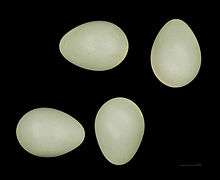Rosy starling
| Rosy starling | |
|---|---|
.jpg) | |
| Male in Almaty, Kazakstan | |
| Scientific classification | |
| Kingdom: | Animalia |
| Phylum: | Chordata |
| Class: | Aves |
| Order: | Passeriformes |
| Family: | Sturnidae |
| Genus: | Pastor Temminck, 1815 |
| Species: | P. roseus |
| Binomial name | |
| Pastor roseus (Linnaeus, 1758) | |
| Synonyms | |
|
Sturnus roseus | |
The rosy starling (Pastor roseus) is a passerine bird in the starling family, Sturnidae, also known as the rose-coloured starling or rose-coloured pastor.[2] The species was recently placed in its own monotypic genus, Pastor, and split from Sturnus. This split is supported by recent studies, though its closest living relatives are still not certainly known.[3]
Description

Adult male (center). female (below), and juvenile (behind)
The adult of this species is highly distinctive, with its pink body, pale orange legs and bill, and glossy black head, wings and tail. Males in the breeding season have elongated head feathers which form a wispy crest that is fluffed and more prominent when the bird gets excited; the crest is shorter in winter and the black areas have paler feather edges, which get worn away as well as the black becoming more glossy in the breeding season. Winter plumage in males is rather dull. Females have a short crest and are duller overall, especially without the sharp separation between pink and black. The juvenile can be distinguished from common starling (Sturnus vulgaris) by its obviously paler plumage and short yellow bill. Young birds molt into a subdued version of the adult plumage, lacking the crest, in autumn and acquire the adult plumage when they are nearly one year old in females, and nearly two years in males. The latter in their second year wear a plumage similar to adult females but with longer crests and noticeably pale feather edges.
Distribution and habitat
The breeding range of this bird is from easternmost Europe across temperate southern Asia.[1] It is a strong migrant, and winters in India and tropical Asia. In India in winter, it often appears to outnumber the local starlings and mynas. The rosy starling is a bird of steppe and open agricultural land. In years when grasshoppers and other insects are abundant, it will erupt well beyond its core range, with significant numbers reaching France and the United Kingdom. The starling is a summer visitor for northwestern Afghanistan, passage migrants in the rest of the Afghanistan and winter visitor in almost entire world population in Sri Lanka and India including the southern India including Karnataka, Kerala, Tamil Nadu, Telangana and Andhra Pradesh.
Habits
They are highly gregarious, in largely noisy flocks and forms the serious pests for the cereal crops. But they also acts as controlling agents of locusts and grasshopper spp. They are strongly attracted to flowering trees. They breeds in tight colonies in very compressed season when more abundance of grasshoppers during May to June.[4]

_near_Hyderabad_W_IMG_4832.jpg)
Food habits
Chiefly fruits, berries, flower-nectar, cereal grains and insects. The observations were made on the feeding habits of rosy starling are: Fruits and berries: Ficus (many species), Lantana spp., Zizyphus oenoplia, Bridelia hamistoniana, Streblus asper, grapes, mulberries (Morus), dates, Salvadora persica, Capparis aphylla and chillies. Flower-nectar: Salmalia persica, Bombax insigne, erythrina indica and E.suberosa, Butea monosperma, Careya arborea. Cereal grains: Jowar and bajra. Insects: largely locusts and grasshoppers, beetles of the families Lucanidae, Elateridae, Tenebrionidae, Buprestidae, Scarabaeidae and Curculionidae.[5]
Behaviour and ecology
The rosy starling is a colonial breeder, and like other starlings, is highly gregarious, forming large winter flocks. It also shares other species' omnivorous diet, although it prefers insects. The song is a typical starling mixture of squeaks and rattles, given with much wing trembling. In Xinjiang, China, farmers used to use insecticide to eliminate locust, which is costly and polluting. In the 1980s, experts found that rosy starlings which fly to Xinjiang farms and feed on locusts could be used for control instead. The experts begin to build artificial nests to attract rosy starlings, an effort reported to be so successful that the number of locusts was insufficient to feed the birds, causing many juveniles die for hunger. By the 2000s many Xinjiang farms greatly decreased the usage of insecticide.[4] [6]
References
- 1 2 BirdLife International (2004). Sturnus roseus. 2006. IUCN Red List of Threatened Species. IUCN 2006. www.iucnredlist.org. Retrieved on 12 May 2006.
- ↑
 Gilman, D. C.; Thurston, H. T.; Colby, F. M., eds. (1905). "Pastor". New International Encyclopedia (1st ed.). New York: Dodd, Mead.
Gilman, D. C.; Thurston, H. T.; Colby, F. M., eds. (1905). "Pastor". New International Encyclopedia (1st ed.). New York: Dodd, Mead. - ↑ Jønsson, Knud A. & Fjeldså, Jon (2006): A phylogenetic supertree of oscine passerine birds (Aves: Passeri). Zool. Scripta 35(2): 149–186. doi:10.1111/j.1463-6409.2006.00221.x (HTML abstract)
- 1 2 Rasmussen, Pamela C.; Anderton, John C. (2005). Birds of South Asia The Ripley Guide (First ed.). Washington DC: NMNH, Lynx Edicions. pp. 582–583. ISBN 84-87334-66-0.
- ↑ Ali, Salim; Ripley, S Dillon (1987). Handbook of the Birds of India and Pakistan (second ed.). New Delhi: Oxford University Press. pp. 163–166. ISBN 978-0-19-565938-2.
- ↑ CCTV誰殺死了粉紅椋鳥
<Snow, David W.; Perrins, Christopher M.; Doherty, Paul & Cramp, Stanley (1998): The complete birds of the western Palaearctic on CD-ROM. Oxford University Press. ISBN 0-19-268579-1
External links
| Wikimedia Commons has media related to Sturnus roseus. |
- Cyberbirding Rosy Starling pictures
- David, J. P., Manakadan, R., & Ganesh, T. (2015). Frugivory and seed dispersal by birds and mammals in the coastal tropical dry evergreen forests of southern India: A review. Tropical Ecology, 56(1), 41-55.]

_near_Hyderabad_W2_IMG_4837.jpg)
_I_Malaysia_005.jpg)